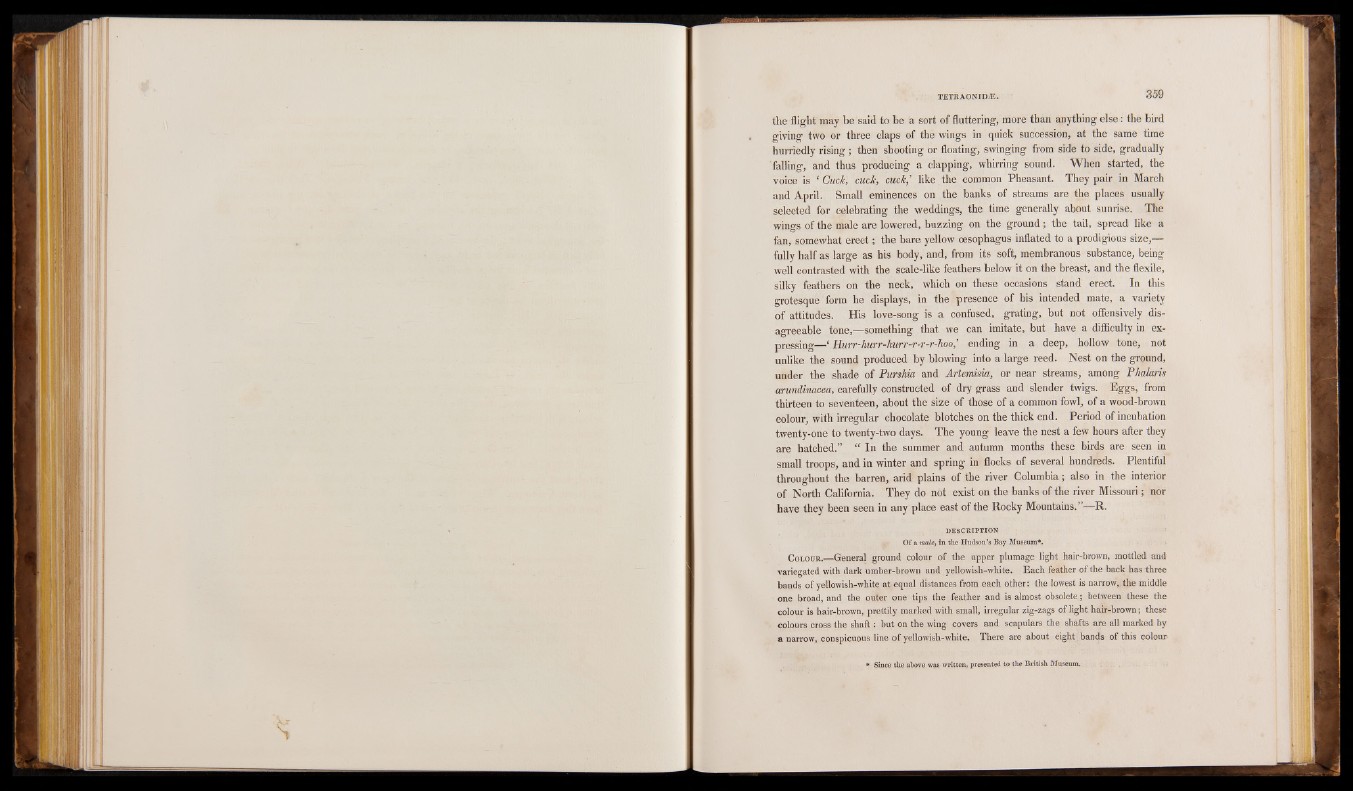
the flight may he said to be a sort of fluttering, more than anything else: the bird
giving two or three claps of the wings in quick succession, at the same time
hurriedly rising; then shooting or floating, swinging from side to side, gradually
falling, and thus producing a clapping, whirring sound. When started, the
voice is ‘ Cuck, tuck, cuck,’ like the common Pheasant. They pair in March
and April. Small eminences on the banks of streams are the places usually
selected for celebrating the weddings, the time generally about sunrise. The
wings of the male are lowered, buzzing on the ground ; the tail, spread like a
fan, somewhat erect; the bare yellow oesophagus inflated to a prodigious size,—
fully half as large as his body, and, from its soft, membranous substance, being
well contrasted with the scale-like feathers below it on the breast, and the flexile,
silky feathers on the neck, which on these occasions stand erect. In this
grotesque form he displays, in the presence of his intended mate, a variety
of attitudes. His love-song is a confused, grating, but not offensively disagreeable
tone,—something that we can imitate, but have a difficulty in expressing—‘
Hurr-hurr-hurr-r-r-r-hoo,’ ending in a deep, hollow tone, not
unlike the sound produced by blowing into a large reed. Nest on the ground,
under the shade of Purshia and Artemisia, or near streams, among Phalaris
arundinacea, carefully constructed of dry grass and slender twigs. Eggs, from
thirteen to seventeen, about the size of those of a common fowl, of a wood-brown
colour, with irregular chocolate blotches on the thick end. Period of incubation
twenty-one to twenty-two days. The young leave the nest a few hours after they
are hatched.” “ In the summer and autumn months these birds are seen in
small troops, and in winter and spring in flocks of several hundreds. Plentiful
throughout the barren, arid plains of the river Columbia; also in the interior
of North California. They do not exist on the banks of the river Missouri; nor
have they been seen in any place east of the Rocky Mountains. ’ MRDESCRIPTION
Of a male, in the Hudson’s Bay Museum*.
C olour.—General ground colour of the upper plumage light hair-brown, mottled and
variegated with dark umber-brown and yellowish-white. Each feather of the back has three
bands of yellowish-white at equal distances from each other: the lowest is narrow, the middle
one broad, and the outer one tips the feather and is almost obsolete.; between these the
colour is hair-brown, prettily marked with small, irregular zig-zags of light hair-brown; these
colours cross the shaft: but on the wing covers and scapulars the shafts are all marked by
a narrow, conspicuous line of yellowish-white. There are about eight .bands of this colour
* Since the above was written, presented to the British Museum.